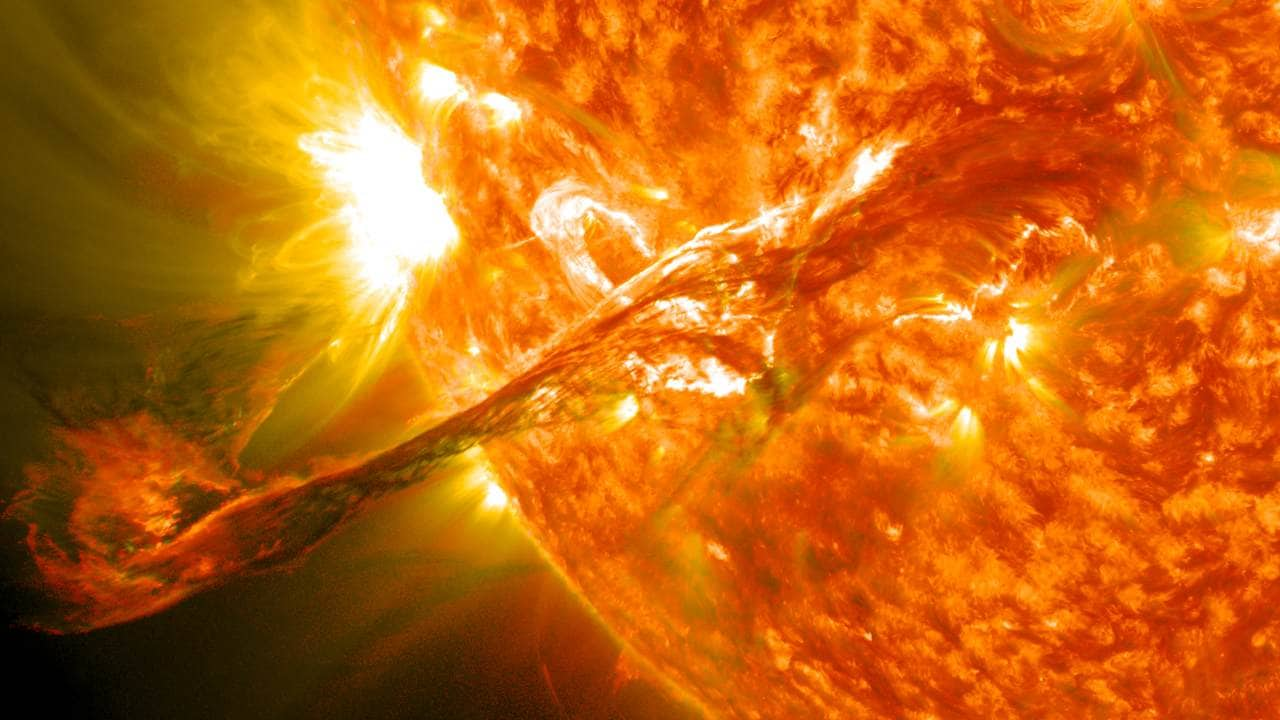SOLAR STORM LIKELY TO HIT EARTH TODAY: GPS, INTERNET, SATELLITES MAY BE AFFECTED
- Get link
- X
- Other Apps
FP TRENDINGJUL 12, 2021 17:58:50 IST
A solar storm is likely to hit Earth today, on 12 July. Solar winds travelling at a speed of 1.6 million kilometres per hour are expected to hit the Earth today and may impact GPS and high-speed internet reported The Indian Express.
A stream of charged particles and high-speed solar winds were created when a hole opened up in the atmosphere of the sun.
These solar flares are the explosions on the surface of the Sun which then release light, high-speed particles and energy into space. The first solar flare of this year happened on 3 July.

On 31 August 2012, a long prominence/filament of solar material that had been hovering in the Sun's atmosphere, the corona, erupted out into space at 4:36 p.m. EDT. Representational image. Image: Wikimedia Commons
It is expected that the solar winds may cause a geomagnetic storm in the magnetosphere. The storms which are caused by the efficient exchange of energy when solar winds enter the Earth’s space are called geomagnetic storms. According to a report in Outlook, this minor storm in the magnetosphere might result in auroras in north and south latitudinous regions.
The Indian Express reports that the satellites which are in the upper layer of the atmosphere might get affected due to the geomagnetic storm. Technologies including mobile phone signal, satellite TV and GPS navigation may get affected due to the storm. It is likely that power grids might also not be operational due to the solar storm.
Quoting the Space Weather Prediction Centre of the United States, the publication reported that high-frequency radio communication might also not be functional for one hour.
The solar flares have been marked at X1 level by the Centre wherein X denotes the classification and the number denotes the strength of the flare. The smallest flares are from the A-class. It is followed by B, C, M and X.
 Centurion: How to get an income by investing $250 in Netflix or other giant companiesInvest In Netflix
Centurion: How to get an income by investing $250 in Netflix or other giant companiesInvest In Netflix Investment of only $250 in Companies like Netflix Could Give you a Second Income!PinkMoon Media
Investment of only $250 in Companies like Netflix Could Give you a Second Income!PinkMoon Media Investment of only $250 in Companies like Tesla Could Give you a Second Income!Invest In Tesla
Investment of only $250 in Companies like Tesla Could Give you a Second Income!Invest In Tesla Invest now $ 200 in Companies like Amazon and get a new income. Here's how to do it!Investments
Invest now $ 200 in Companies like Amazon and get a new income. Here's how to do it!Investments
![[Pics] Remember This WWE Star? Wait 'Till You See Her Now [Pics] Remember This WWE Star? Wait 'Till You See Her Now](https://images.outbrainimg.com/transform/v3/eyJpdSI6Ijk1YTA5ZWQwZmFhYzU4YzBhZGM2NTJiZmExNmE2YzE3ZmQ4MDI0OTlhNGY2MTRlNGYzNjBkZGRhYmQ5NDEwMmEiLCJ3IjozNjAsImgiOjI0MCwiZCI6MS41LCJjcyI6MCwiZiI6NH0.webp) [Pics] Remember This WWE Star? Wait 'Till You See Her NowOcean Draw
[Pics] Remember This WWE Star? Wait 'Till You See Her NowOcean Draw People Born 1957-1992 (With No Life Insurance) Should Claim This Benefit In June 2021bettermoney.co.za
People Born 1957-1992 (With No Life Insurance) Should Claim This Benefit In June 2021bettermoney.co.za We Will Guess Your Education Level in 20 QuestionsParentsdome Galleries
We Will Guess Your Education Level in 20 QuestionsParentsdome Galleries![[Photos] He's Considered One of the Greatest Goalkeepers of All Time [Photos] He's Considered One of the Greatest Goalkeepers of All Time](https://images.outbrainimg.com/transform/v3/eyJpdSI6IjE4ZWMyODJjMGQ3Mjc2Y2JkZGM2MGUyZjk4NjI1MWQxNjFhYjZlNmE5NTZjOGQ5NTZiMDcyMDgzMDgxNzBjY2QiLCJ3IjozNjAsImgiOjI0MCwiZCI6MS41LCJjcyI6MCwiZiI6NH0.webp) [Photos] He's Considered One of the Greatest Goalkeepers of All TimeFootball.com
[Photos] He's Considered One of the Greatest Goalkeepers of All TimeFootball.com
 Your IQ Is 142 If You Get 15/20 On This General Knowledge QuizParentsdome Galleries
Your IQ Is 142 If You Get 15/20 On This General Knowledge QuizParentsdome Galleries![[Gallery] These Are The Wives Of The World's Richest Men [Gallery] These Are The Wives Of The World's Richest Men](https://images.outbrainimg.com/transform/v3/eyJpdSI6Ijg3MzZmNmU5NzUxY2Q0NmZjYjE0MTI0N2NlNzA4ZDczZWU3ZjFkYTUxZDFiZTg4Y2FjMTg0NmY5ODgzNDExY2MiLCJ3IjozNjAsImgiOjI0MCwiZCI6MS41LCJjcyI6MCwiZiI6NH0.webp) [Gallery] These Are The Wives Of The World's Richest MenSizzlfy
[Gallery] These Are The Wives Of The World's Richest MenSizzlfy![[Gallery] 40 Women From The 90's Everyone Had A Crush On [Gallery] 40 Women From The 90's Everyone Had A Crush On](https://images.outbrainimg.com/transform/v3/eyJpdSI6Ijk3ZGRjY2I3OGU1Y2IxNDQ0NzA3NWVlZWQzNWFlMDI0YjgxZTY2MTc3ZTk5Yzg2MDZmZmFjMWQzYTRlMWYwNTUiLCJ3IjozNjAsImgiOjI0MCwiZCI6MS41LCJjcyI6MCwiZiI6NH0.webp) [Gallery] 40 Women From The 90's Everyone Had A Crush OnSizzlfy
[Gallery] 40 Women From The 90's Everyone Had A Crush OnSizzlfy Centurion: How to get an income by investing $250 in Tesla or other giant companiesPinkMoon Media
Centurion: How to get an income by investing $250 in Tesla or other giant companiesPinkMoon Media
Find latest and upcoming tech gadgets online on Tech2 Gadgets. Get technology news, gadgets reviews & ratings. Popular gadgets including laptop, tablet and mobile specifications, features, prices, comparison.
Comments
Post a Comment